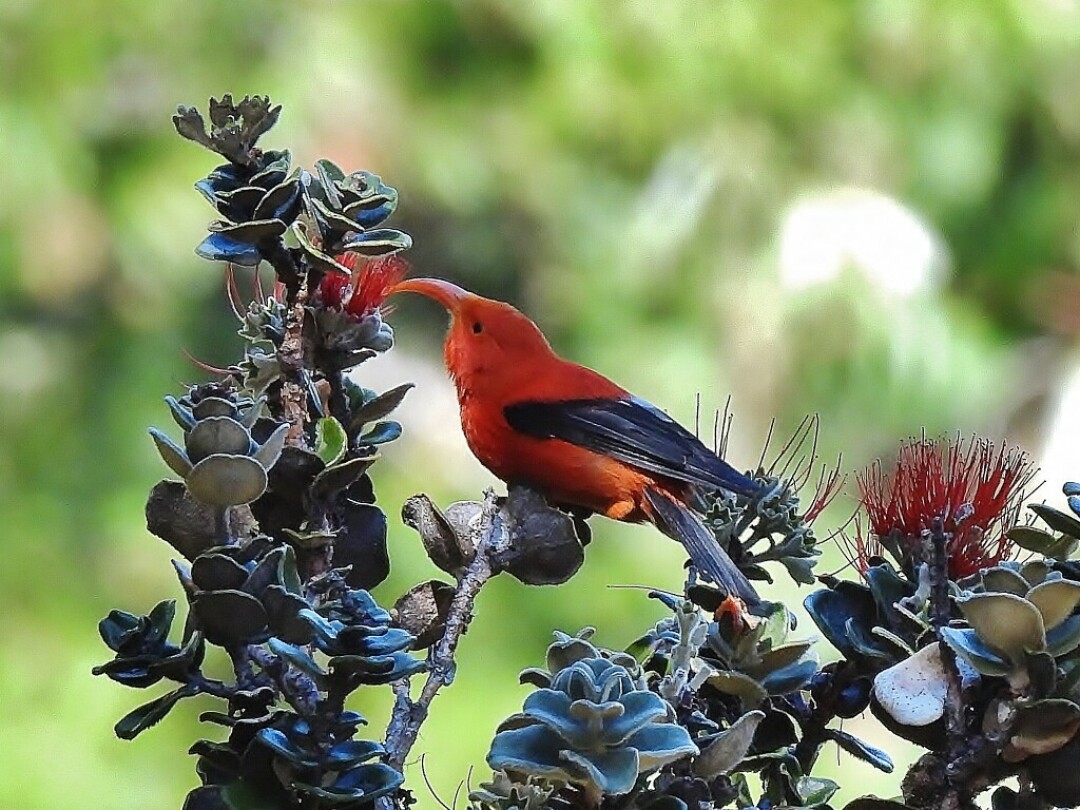News & Articles
Browse all content by date.

ʻIʻiwi look very similar to ʻApapane, but have a bright orange, curved bill. This one is feeding on 'Ōhi'a flowers at high elevation – where malaria-carrying mosquitoes can’t survive. Photo by Emily Stone.
In an unexpected twist, cool drizzle greeted my parents and me for our first day on the Big Island of Hawaii. Once the sun finally came out days later and it felt like a steam room, we looked back on that gray day very fondly. The clouds were perfect for exploring the scrubby young forests on the Pu'u O'o Trail, which meanders over several different ages of lava flows from Mauna Loa.
As with most places in Hawaii, the plants along the trail were a mix of native and introduced. Hot pink knotweed flowers from Asia were strikingly beautiful against the black lava surfaces. They complemented the vibrant greens of the native polypody fern, ʻAe Lau Nui. Lichens had preceded the plants, built up soil, and facilitated seed germination, and they were still cultivating soil in many nooks and crannies.
The native 'Ōhi'a lehua trees didn’t wait for the lichens to put out the welcome mat. Their tiny, airborne seeds are able to blow in, find a crack, and grow. I’m pretty sure that every single tree taller than our heads was an 'Ōhi'a tree, and most plants at shrub height were, too. Many of them bore scattered flowers, each a Dr. Seussian tuft of scarlet stamens about the size of a clementine.
Movement among the flowers caught my eye, so I slipped my binoculars from beneath my rain jacket and focused through the mist. A bright red bird with black wings hopped among the flowers, probing for the 'Ōhi'a’s prolific nectar with a sharp black beak.
While the bird looked a lot like the scarlet tanagers who nest in the Northwoods, I knew it was not.
“ʻApapane!” I called to my parents, and guided their eyes to the bird.
Less than 24 hours on Hawaii, and we’d just spotted one of our target species for the trip! It’s no accident that ʻApapanes’ scarlet feathers match the red of the blossoms they rely on. The camouflage makes them very hard to spot! A brush-tipped tongue perfect for sipping nectar further emphasizes their close relationship with 'Ōhi'a lehua blossoms.
The fact that ʻApapane are the most abundant species of Hawaiian honeycreepers, and scientists estimate that their population is about equal to the human population on the islands, didn’t dampen my enthusiasm at seeing this endemic bird who only lives in Hawaii.
A little farther down the trail, we spotted more movement in the trees. Another red bird masqueraded as a flower, but while the red body and black wings looked just like an ʻApapane to me, the beak was bright orange and strongly curved. Having studied our field guides, I knew that this was an ʻIʻiwi (pronounced ee-EE-vee).
These two red birds share more than a love of ‘Ohi’a nectar. They both descended from the same flock of rosefinches from Asia who got blown off course roughly five million years ago, and found refuge on the young island of Kaua’i. Finding pleasant weather, lots of food, and few predators, the birds survived, eventually expanding to the other islands as those volcanoes rose above the ocean.
In order to avail themselves of the many different habitats and food sources on the islands, the birds began to specialize. Just like with Darwin’s finches on the Galapagos Islands, some adapted to cracking seeds, others to sipping nectar, some even figured out how to act like woodpeckers. This is called “adaptive radiation,” where one species becomes many, so that they can take advantage of different resources and living conditions. Collectively, we call these birds Hawaiian honeycreepers.
Wikipedia lists 60 species of Hawaiian honeycreepers, but only 15 are still alive today. While the Endangered Species Act that tries to protect these birds is celebrating its 50th anniversary this year, it’s an uphill battle. Eight Hawaiian birds were declared extinct just this past October.
Theirs is a common plight on Hawaii, a hotbed of extinctions. The few plants and critters who arrived on their own lived for eons with no ground predators, no parasites, no mosquitoes, and no grazing animals. Once humans – first the Polynesians and then the Europeans – brought habitat destruction, pigs, cats, rats, mongooses, diseases, and invasive plants, the original inhabitants suffered.
Perhaps it won’t surprise you that mosquitoes are some of the worst villains on Hawaii, at least in relation to the native birds. The mosquitoes picked up avian malaria from some infected transplanted bird, and now spread it among the endemic birds, causing widespread death. ʻIʻiwis are one species at high risk. They have no disease resistance, and only hold on by staying at higher elevations that are too cold for mosquitoes. As the climate warms, their safe habitat will shrink.
Happily, the beautiful ʻApapane have developed some genetic resistance to the disease, and are doing relatively well. They serenaded us on many forest walks. An ʻApapane’s song may contain more than 400 different syllables, so listening to this single species warble through the forest canopy made it feel like there was still a lovely chorus. They are a bright spot in a landscape of loss.
Emily Stone is Naturalist/Education Director at the Cable Natural History Museum. Her award-winning second book, Natural Connections: Dreaming of an Elfin Skimmer, is available to purchase at www.cablemuseum.org/books and at your local independent bookstore, too. For more than 50 years, the Cable Natural History Museum has served to connect you to the Northwoods. Our exhibit: “The Northwoods ROCKS!” is open through mid-March. Our Winter/Spring Calendar of Events is ready for registration! Follow us on Facebook, Instagram, YouTube, and cablemuseum.org to see what we are up to.
| Tweet |


